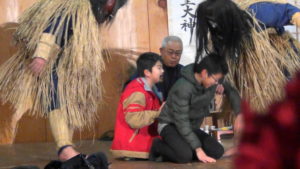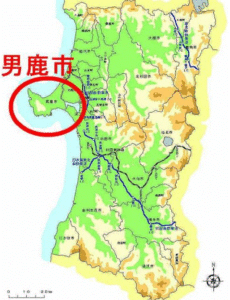Namahage – The most famous ogre in Japan

Well, we’ll pick up “Namahage”, today.
about “Namahage Sedo Festival”→Namahage sedo Festival
”Namahage” is the most famous traditional character in Japan. At the end of 2018, it was added to the UNESCO intangible Culture Heritage List, as one of the group of ‘visiting deity’ folk rituals. Namahage has long hair and a demonic face, the eyes shine glitteringly, two big tusks overhang from its big mouth. It wears a traditional cape (mino 簔), holding a big kitchen knife and a wooden pail. They come from the mountains to their territory’s village at New Year Eve, in snow. Namahage walk around a village, suddenly knock on a door and get into the house while screaming “Aren’t there any crying children?” “Aren’t there any lazy person?” Children run about to escape and hide behind parents while crying out in a loud manner. Namahage will try to catch them. For children, they are real nightmares

Are Namahage demons? Are they messengers from the world of Satan? The answer is “No”. The people of this region accept them with pleasure. They recognize them as a messenger bringing regional fortune. The people treat Namahage politely with a feast with sake.
Where is Oga ?
These demonic beings emerge in the Oga peninsula of Akita prefecture.

Akita prefecture

Oga peninsula
The Oga Peninsula is isolated from the other area especially in winter because its three sides are surrounded by the sea and another side is wash land. Akita prefecture is known as a deep-snow district, cold winds blowing from the Sea of Japan. People must cooperate with each other to overcome severe natural environments. No man must be lazy. Namahage, therefore, emerge from mountains to admonish people not to neglect hard work. The targets of Namahage are newcomers in this region, children or new wives (husbands) to teach the rule of this region.
Sacred visitor
In the word Namahage’s “hage” (“hagu”) means ‘tear off’. People believe that warming at a fire for long time cause to create a callus. In this region, people call it “namomi” or “namami”. Namahage come to tear it off. Namahage “hagu” (tear off) “namomi (callus). Similar events are all over Japan. People call this callus in each region, “namomi”, “nagame”, “nagomi” etc. For example, there is “Nagomihagi” (in another region of Akita), “Amamehagi” (in Noto peninsula of Ishikawa) and so on. We will introduce them someday in this site.

from http://www.notocho.jp/event/630/ Noto town

from https://www.city.noshiro.lg.jp/section/kyoiku/gakushu-sports/kominkan-bunka/16384 Noshiro city
Legend
What is the origin of Namahage? Today, several legend have been handed down. Mainly there are three. One is that Wu, the emperor of Han (Han is a old name of China, about 2nd century BC) came in this region with five ogres. People say the long steps which lead five shrines named “Goshado” in this district were built by three ogres.The second legend is that a foreigner drifted here and stored to live in the mountains. The third legend is that “Shugenja”, a monk who leads an ascetic life in the mountain sometimes came down to the village. The figure of the person seemed to like an ogre. Many legends have been handed down, but unfortunately, we have no sure evidence. In any case, we suppose that someone came into the village from the mountain or sea in ancient times. When did it begin? The oldest source is recorded in 1811 (Edo period) by Sugae Masumi (菅江真澄)who was a traveler around the northern region of Japan. But popular folk events are not officially recorded, so we can’t know for sure.

from https://thegate12.com/spot/463 the gate

from https://www.namahage-oga.akita.jp/english/ Oga town
The ritual of Namahage is carried out in at least 80 regions. In its heyday, there were 140 regions, but now numbers are decreasing. Here are some reason I guess. Population decrease, Lifestyle of people have changed and so on. But we can’t help but wish this special ritual for children doesn’t heyday vanish.
Refer→”Namahage Sedo matsuri” about namahage more information https://discoverdeeperjapan.com/2020/02/07/namahage-sedo-matsuri/